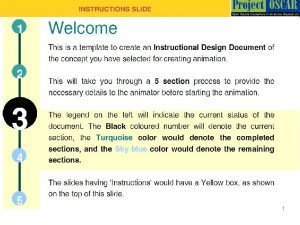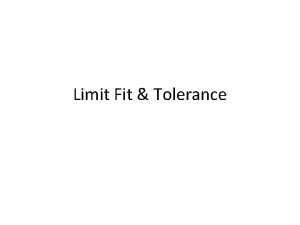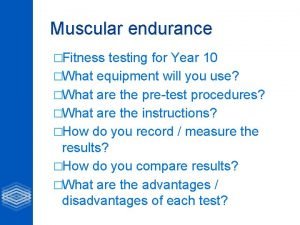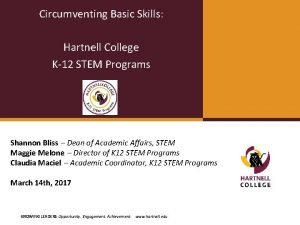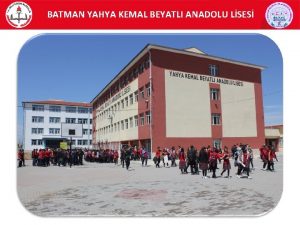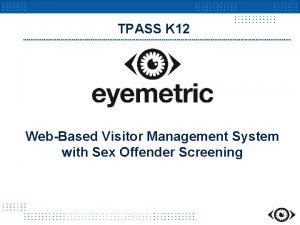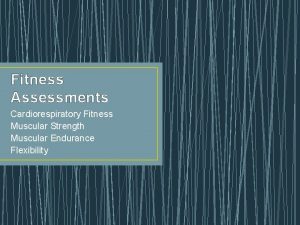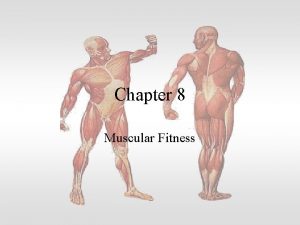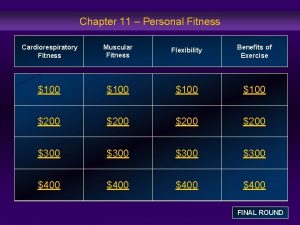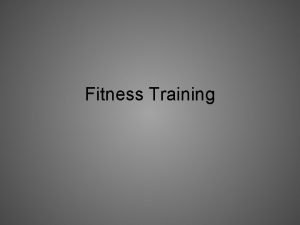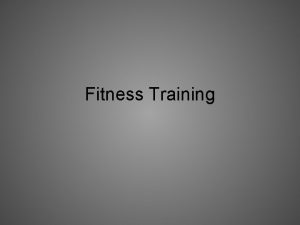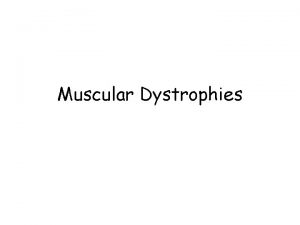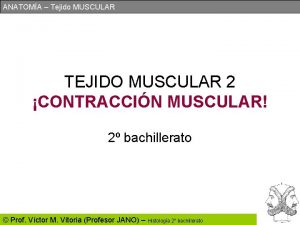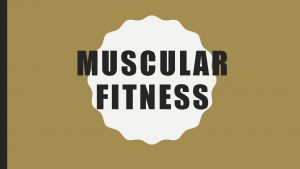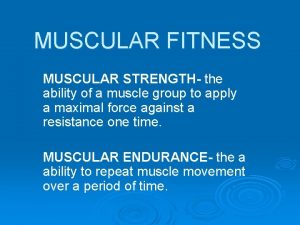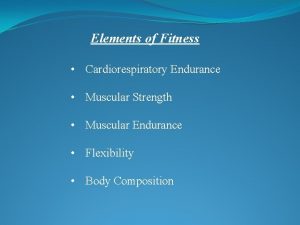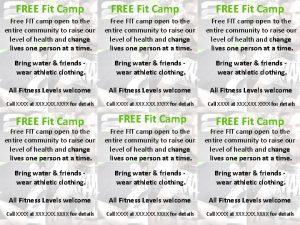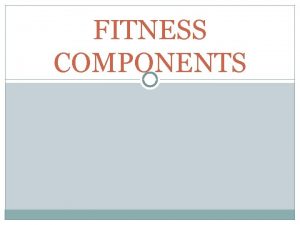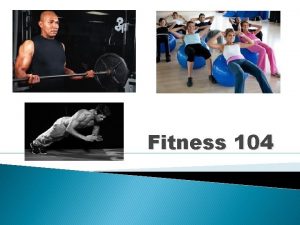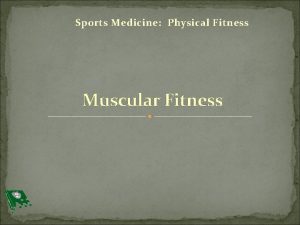Functional Muscular Fitness Training K12 with Cross Fit




















- Slides: 20

Functional Muscular Fitness Training K-12 with Cross. Fit During this 3 session series we will share how we have integrated the Cross. Fit Training Program throughout our K-12 physical education program. Come to this program expecting to gather a basic understanding of; the core concepts of the Cross. Fit program, how you can safely scale foundational exercises and workouts for all students, and how to build a program where students work together to achieve personal goals and improve fitness assessment performance.

Why Cross. Fit? How did we arrive at using Cross. Fit as our preferred method of teaching muscular fitness? • • As you implement your PEP Grant may salesmen will try to sell you expensive selectorized equipment. Is that what is best for students? • Is it regularly accessible? • Is it functional, do our muscles usually work in isolation? • Not classroom friendly. Can you teach and supervise 30 different stations adequately? • It is a ball and chain to a gym! • One machine costs between $1, 500 to $4, 000 dollars. How much would that buy of the following; med balls, jump ropes, resistance bands Provides for a maximum number of teachable moments. • Reproduces real life skills. Helps you to improve your “Quality of Life” • Helps produce an educated consumer who understands and can evaluate new fitness trends. More bang for your buck!

Session Overview: Session 1: The 9 Foundational Movements Session 2: Sample Cross. Fit Workouts Session 3: Classroom Our Presentation can be viewed online at: http: //www. northallegheny. org/page/7093

Session 1: The 9 Foundational Movements In this presentation, we will provide a “hands on” experience that will enable you to begin teaching “High Intensity, Functional Movements” in your gym tomorrow. During this presentation, you will be introduced to 9 exercises that demonstrate the fundamental movement patterns associated with all activities of life. You will identify the basic teaching points of each movement and the cues used to see immediate improvements in the function of your students. Using these movements, you will have the opportunity to participate in a workout that can easily be geared to the grade level of your choice. This session will allow you to see not only how to teach High Intensity, Functional Movements, but how to scale it for participation in all grade levels and ability levels. No child should be left behind when it comes to learning how to perfect body movements. During this presentation, there will be 3 separate mini-lessons identifying the Squat series, Deadlift Series and Overhead Press series. Upon completion of this fundamentals session, 1 -2 workouts will be provided to allow you to see the movements in action and to perform the workouts at the scaled level of your choice based on teaching, ability or fitness level. Mini Session #1: Air Squats, Front Squats, Overhead Squats Mini Session #2: Shoulder Press, Push Jerk Mini Session #3: Deadlift, Sumo Deadlift High Pull, MB Cleans

The 9 Foundational Cross. Fit Lifts Squat Series Press Series Deadlift Series Simplest (Elementary) The Air Squat The Press The Deadlift is foundational to. . . More Complex (Middle School) Front Squat Push Press is foundational to. . . Sumo Deadlift High Pull is foundational to. . . Most Complex (High School) Overhead Squat 9 Foundational Lifts: video examples cue sheets Push Jerk Medicine Ball Clean

Air Squats, Front Squats, Overhead Squats Air Squat Teaching Cues ● Weight on heels ● Knees Track Toes (Knees Out) ● Hips Down and Back ● Hips to Knees ● Chest Front Squat Teaching Cues ● Same as Air Squat ● Add Front Rack o Hands Outside shoulder o Finger Grip o Bar on Shoulders o Upper Arm Parallel Overhead Squat Teaching Cues ● Same as Air Squat ● Add Active Shoulders o Armpits forward o Shoulders to Ears

Shoulder Press, Push Jerk Shoulder Press Teaching Cues ● Midline Stability ● Feet Under Hips ● Elbows in front of wrist ● Wrist outside shoulder ● Quads, Guts and Butts ● Pull Chin Back ● Active Shoulder ● Bar in Frontal Plane o Armpits forward o Shoulders to Ears Push Press Teaching Cues ● Same as Shoulder Press ● Bar on Body ● Add Sequence o Dip, Drive, Press o 3” Knee Drop Forward Push Jerk Teaching Cues ● Same as Shoulder Press ● Bar on Body ● Add Sequence o Dip, Drive, Press/Catch, Stand (Push Jerk)

Deadlift, Sumo Deadlift High Pull, Med Ball Cleans Deadlift Teaching Cues ● Feet Under Hips ● Arms are strap ● Shoulders in front of bar ● Bar on Shin ● Neutral Spin ● Knees below hip, hip below shoulder SDHP Teaching Cues ● Widen Feet Outside Shoulder ● Grip Inside Shoulders ● Shrug to Pull ● Hips then Arms o High Pull after Hips reach full extension MB Cleans Teaching Cues ● Feet Under Hips (Jump&Land) ● Arms are straps ● Shoulders in front of bar ● Bar on Shin ● Neutral Spin ● Knees below hip, hip below shoulder ● Drive High o Deadlift with Shrug ● Catch Low o Push Under Ball

Sample Workouts WOD: 10 -8 -6 -4 -2 For Time • • • AIR SQUATS MB CLEANS PUSH PRESS WOD: 7 Minute AMRAP • • • 20 AIR SQUATS 10 MB CLEANS 10 PUSH PRESS

Session 2: Sample Cross. Fit Workouts In this second of a three part series, we will offer a hands-on introduction to a variety of Crossfit workouts and exercises used within our curriculum. All exercises will be demonstrated with scaling options for all age/readiness levels. Attendees will be encouraged to participate in the activities which will include ideas for warm-up, introduction to skills and cues for correction, and a short opportunity to engage in the workout. In addition, we will demonstrate how to use Crossfit Methodology, i. e. Constantly Varied, Functional Movements performed at High Intensities, in a manner that meets the needs of your students. NA Cross. Fit Page

Hero WOD’s 1. Lumberjack “ 20” a. 20 Deadlift, 20 KB Swings, 20 Overhead Squats, 20 Burpees, 20 Pull-ups, 20 Box Jumps, 20 DB Squat Clean (Run 400 m between each exercise) 1. Michael a. 3 RFT (800 m, 50 Back Ext. , 50 Situps) 1. Whitten a. 7 RFT (15 KB Swing, 15 Cleans (95 lb), 15 Box Jump) 1. Rahoi a. 12 Min. AMRAP (12 Box Jumps, 6 Thrusters (95 lb), 6 Bar Facing Burpees

“The Murph” Partition the pull-ups, push-ups, and squats as needed. Start and finish with a mile run. If you’ve got a twenty pound vest or body armor, wear it. In memory of Navy Lieutenant Michael Murphy, 29, of Patchogue, N. Y. , who was killed in Afghanistan June 28 th, 2005. This workout was one of Mike’s favorites and he’d named it ‘Body Armor. ’ From here on it will be referred to as ‘Murph’ in honor of the focused warrior and great American who wanted nothing more in life than to serve this great country and the beautiful people who make it what it is. The Murph Middle-Murph Mini-Murph 1 mile run ½ mile run ¼ mile run 100 Pull-ups (10 x 10) 50 Pull-ups (10 x 5) 25 Pull-ups (5 x 10)) 200 Push-Ups (10 x 20) 100 Push-Ups (10 x 10) 50 Push-Ups (5 x 10) 300 Squats (10 x 30) 150 Squats (10 x 15) 75 Push-Ups (5 x 15) 1 mile run ½ mile run ¼ mile run

Benchmark “Girls” WOD’s 1. Fran a. 21 -15 -9 Thrusters, Pull-ups 1. Cindy a. 20 Min AMRAP of 5 Pull-ups, 10 Push-ups, 15 Squats 1. Helen a. 3 RTF of 400 m Run, 21 KB Swings, 12 Pull-ups 1. Barbara a. 5 RFT of 20 Pull-ups, 30 Push-ups, 40 Sit-ups, 50 Squats 1. Nancy

Fitness. Gram WOD’s 1. Fitness. Gram 5 Minute AMRAP a. Complete each exercise for 5 “Strict” form reps before rotation i. Push-ups, Curl-ups, Pull-ups, Trunk Lift, 20 Meter Sprint 1. Fitness. Gram Tabata a. 8 Rounds for Reps (20 on: 10 off) i. Push-ups, Curl-ups, Pull-ups, Trunk Lift, 20 Meter Sprint 1. 5 -2 Interval Skill a. Go to farthest range of motion for each exercise and hold for 5 count rest for 2 count and repeat. (For example go bottom to the bottom on a squat and hold for 5 seconds, come up for 2 seconds and repeat. )

Other WOD’s 1. Baseline- (400 m Row, 40 Squats, 30 Sit-ups, 20 Push-ups, 10 Pull-ups) 2. Sport Specific Warm-up/Workout Ideas a. 5 Min AMRAP Ladder of 4, 6, 8, 10…. MB Woodchoppers, Fwd/Bwd Line Touches, Speed Skaters, T-Pushups 3. Self-Designed Workouts a. Chipper, Couplets/Triplets, Single Modality b. AMRAP, RFT, EMOMing c. Timed workouts vs. AMRAP

Self-Made Workouts 1. AMRAP- As many rounds/reps as possible a. 15 Min AMRAP of. . i. 25 KB Swings ii. 15 Wall Ball iii. 5 Pull-ups 1. For Time- Complete workout in fastest time possible a. Complete 4 Rounds for Time of. . . i. 400 M Run ii. 40 Bottom to Bottom Squats iii. 10 Handstand Push-up (Variations)

Self-Made Workouts 1. Chipper- Complete a series of exercises one at a time for time a. For time: i. 25 Box jump, 24 inch box ii. 25 Jumping pull-ups iii. 25 Knees to elbows iv. 25 Push press, 45 pounds v. 25 Back extensions vi. 25 Wall ball shots, 20 pound ball vii. 25 Burpees viii. 25 Double unders 1. EMOM- Every minute on the minute, complete given exercises a. 5 SDHP b. 15 Push-ups

Session 3: Classroom In this session will look at authentic assessment strategies using video and Google Docs/Drive to promote proper execution of Cross. Fit Skills. We will discuss why we use Cross. Fit as a component of our Physical Education Curriculum and how we have implemented the program. Finally will share the many available resources that are available pertaining to Cross. Fit. There will be time at the end of the session for questions and answers. ○ Authentic assessment strategies ○ ○ lesson progression Use i. Pad / phone video analysis to self / partner assess video Medball Clean and Press: Self Analysis Form, Results Spreadsheet Fitness. Gram - Integrating Fitness. Gram exercises into Cross. Fit style AMRAP and/or Tabata workouts to improve fitness and provide formative assessments. ○ Keeping up to date and getting ideas ○ ○ Cross. Fit: http: //crossfit. com/, Facebook and Twitter Feeds http: //www. mobilitywod. com/ Cross. Fit Kids: http: //www. crossfitkids. com/, https: //twitter. com/Cross. Fitkids, https: //www. facebook. com/crossfitkids ○ Round table discussion Cross. Fit Kids Article ○ Question, answer, and discussion session Why Cross. Fit -----> Share Cross. Fit Kids as a PE Curriculum Article ------> This is an extreme view that we don’t wholeheartedly agree with. Physical Education has to be more that just Cross. Fit but there is a lot of positive takeaways -----> variation provides fun and minimizes injury

Excerpts from: Cross. Fit Kids as a Physical Education Curriculum: A Pedagogical Perspective Phil Eich makes a case against traditional physical education, in which sports form the foundation but provide little motivation toward lifelong fitness. Cross. Fit Kids uses “The Literal Model” Literally, “physical education” means the teaching and learning of the use and care of the body, and so the literal model builds on one of the body’s most basic functions: movement. Traditionally, movements taught within the physical-education class are sport specific (swinging a bat, throwing a ball, shooting a basket). The literal model, however, uses the most basic movements of the body because they have the most direct and broad application to all life’s experiences. Foundational movements of the body—such as squatting, pushing and pulling—are found both in athletic environments as well as within the physical requirements of everyday life. In the literal model, the priority given to the foundational movements of the body will increase proprioception (the internal awareness of movement) and kinesthetic awareness (the external awareness of the body in time and space) as well as work capacity. Developing physical competency in these basic movements translates into increased fitness, improved physical abilities and injury prevention. Improving Lives As teachers, we have an incredible privilege and responsibility to give the best of what we know to our students. Cross. Fit Kids provides teachers with the concepts and the curriculum necessary to improve the physical well-being of people from childhood through adulthood in meaningful, life-affirming ways. Where there is always a need for sports and games, using Cross. Fit to fulfill the literal model of physical education allows the teacher to contribute to the empowerment of every single student’s self-determination. Children can begin to live physical lives of choice unconstrained by the restrictions of poor health, unnecessary injury or lack of physical skill.

Resources • Our Presentation can be viewed online at: http: //www. northallegheny. org/page/7093 • • www. Cross. Fit. Kids. com (Work and Family Safe) www. Cross. Fit. com The Cross. Fit Journal - http: //journal. crossfit. com/ Sports and Overtraining issues in young athletes - www. stopsportsinjuries. org Kids and weightlifting - Pediatrics, Volume 121, Number 4, April 2008 policy statement of the American Academy of Pediatrics, www. aap. org, http: //aappolicy. aappublications. org/cgi/reprint/pediatrics; 121/4/835. pdf 2008 policy statement of Canadian Society for Exercise Physiology, www. csep. ca, http: //www. csep. ca/cmfiles/publications/CSEPPosition-Stand-E. pdf Journal of Strength and Conditioning Research, August; 23(5): 560 -579, 2009 policy statement of the National Strength and Conditioning Association, www. nsca-lift. org - http: //www. nsca-lift. org/Publications/Youth. Resistance. Training. Updated. Position 2. pdf
 First fit next fit best fit worst fit
First fit next fit best fit worst fit First fit best fit worst fit testing
First fit best fit worst fit testing Difference between strength and endurance
Difference between strength and endurance Transition fit
Transition fit Person-job fit and person-organization fit
Person-job fit and person-organization fit Muscular strength fitness test
Muscular strength fitness test Health vs skill related fitness
Health vs skill related fitness Dominant business diversification strategy
Dominant business diversification strategy Retrenching to a narrower diversification base:
Retrenching to a narrower diversification base: Space maintainer classification
Space maintainer classification Non functional plasma enzyme example
Non functional plasma enzyme example Enzymes in plasma
Enzymes in plasma Functional and non functional
Functional and non functional Ic.wpcsd
Ic.wpcsd K12
K12 School vouchers pros and cons
School vouchers pros and cons K12cart
K12cart K12
K12 Val.meb.k12 batman
Val.meb.k12 batman Ero henrico k12 va us
Ero henrico k12 va us Visitor checkin software
Visitor checkin software
